Glaistig of Scottish Folklore
Ah, Scotland—just picture it. I'm sure you can—and if there were a way to capture and compare our mental images, they'd be strikingly similar, except...
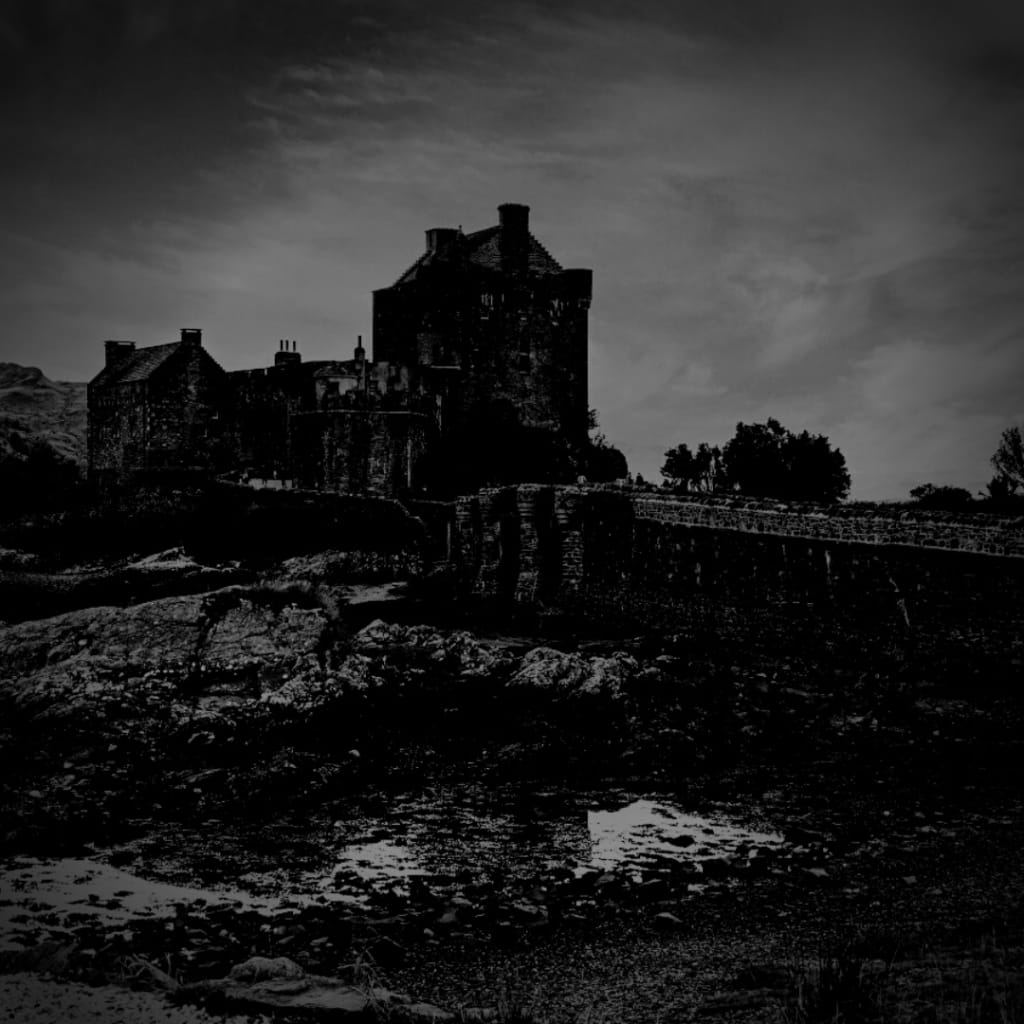
Ah, Scotland - just picture it. I'm sure you can - and if there were a way to capture and compare our mental images, they would be strikingly similar. Towering mountains and hidden glens, mossy forests and foggy bogs, gently rolling moorlands and glittering lochs, highland cattle and cloven-hoofed ghosts wailing as they chase you for your blood.
Okay, so our mental images didn't line up 100% there. It was the moorlands, right? It's always the moorlands. Were you picturing purple heather moorlands or the wetter moorland variety with sphagnum moss? It's okay - that one always trips people up.
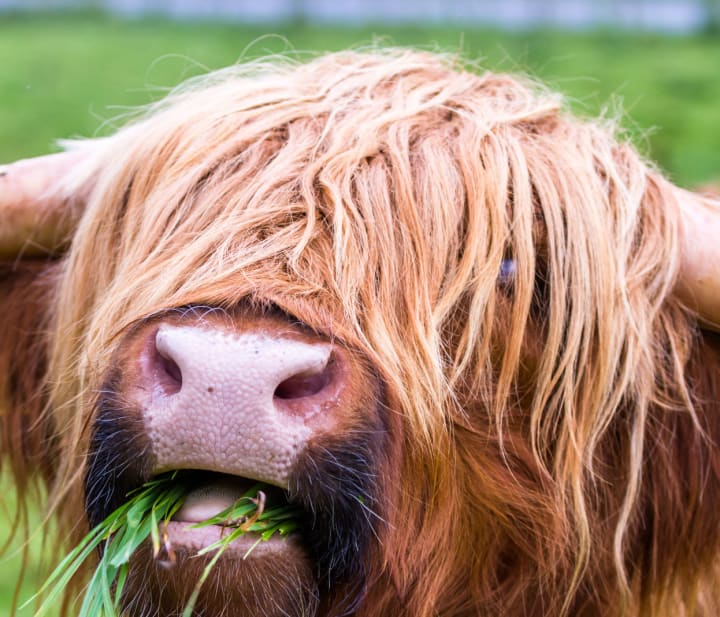
To Scotland!

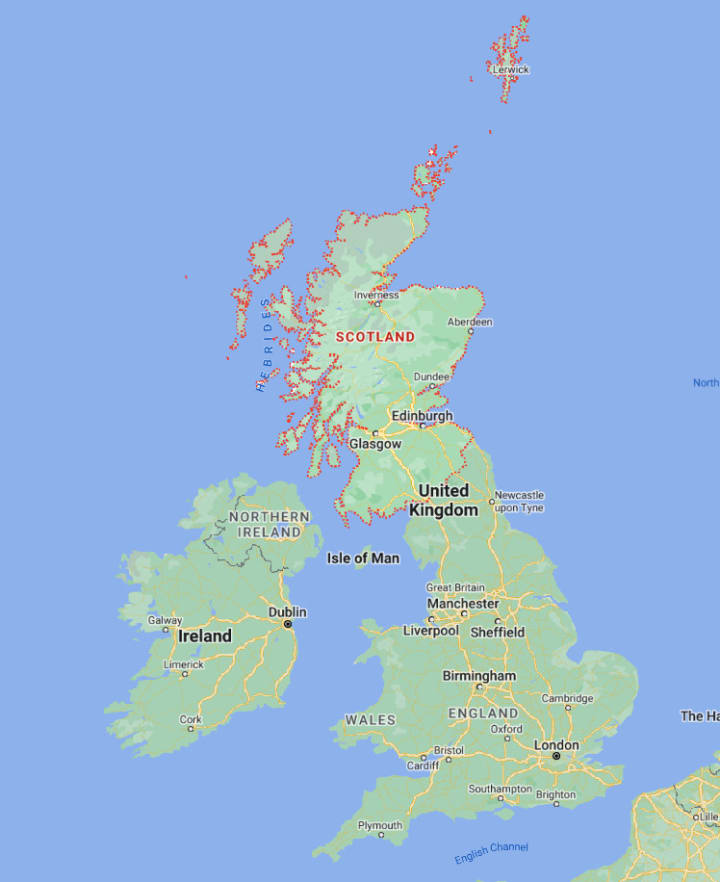
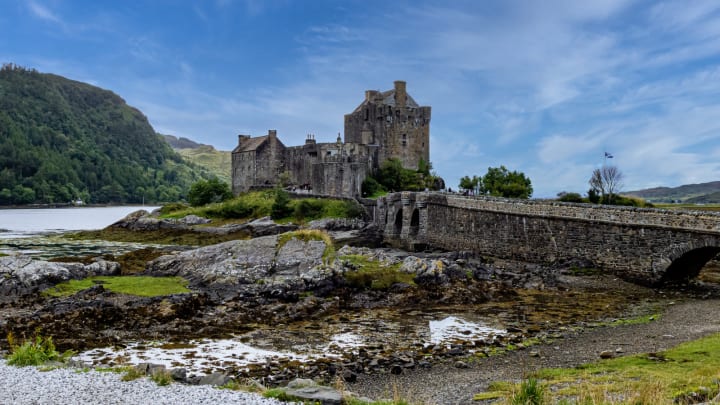
How to Pronounce Glaistig
I'm pleasantly surprised when I find a native pronunciation for a word, like Glaistig, right here on Forvo.com. The sound is somewhat similar to the English word "plastic" - although the L sound is quite different than the usual L in English. According to my research, the term is pronounceable in both Scottish and Irish, with Goidelic (or Gaelic) language roots.
For specific languages, like Gaelic, there are entire resources devoted to learning the language, and sometimes we're lucky enough that words like Glaistig can be found within their resources. As it happens, LearnGaelic.scot has a searchable dictionary with pronunciations for all sorts of things, including Glaistig.
Be careful out there when trying to find how to pronounce words because the TikTok robot voices have invaded YouTube and other sites, providing complete trash for pronunciation guides like this one and this one. If you think that's bad, just wait until you hear what I dug up when writing about a type of vampire in The Vrykolakas of Greek Folklore.
Fun With Grammarly
I like to run most things I write through Grammarly Premium - it's an excellent service (this is not a paid promotion; I'm just quite fond of Grammarly).
For the topics I write about on Into Horror History, Grammarly often doesn't know what I'm talking about, like "Glaistig." It keeps suggesting that I've misspelled the word and that I actually mean "glaciating."
gla·ci·ate
transitive
verb
gla·ci·at·ed, gla·ci·at·ing, gla·ci·ates
1. to cover with ice or a glacier.
2. To subject to or affect by glacial action.
3. To freeze.
To be fair, I have my language set to English. To be figuratively glaciating of Grammarly, the tool doesn't know Gaelic is a language.
What is a Glaistig?
In Scottish Highland folklore, there are malevolent spirits called "fuath."
You're going to want to listen to the pronunciation of "fuath" over at LearnGaelic - it's probably not what you think, as the "th" is more like an English "h" sound. The word "fauth" can mean "hatred" as well as "spectre" - which already kind of implies where we're headed with the Glaistig.
The Glaistig is a shapeshifter and can appear as a goat or as a woman from the waist up, with her lower half that of a goat. In her half-human half-goat form, she's typically wearing a long green dress, which obscures her legs and feet. Some stories tell of a beautiful woman in a green dress who asks to be carried across a stream. Unfortunately, for most of us mere human mortals like us, there doesn't seem to be a predictable way to handle an encounter with the Glaistig. Her treatment of you may range from intentionally getting you lost all the way to slitting your throat and draining you of your blood. If you are a herder in Scotland, you may fare better, as the Glaistig protects cattle and herders.
There's another version of the Glaistig that refers to her as "Maighdeann Uaine" - which, literally translated, means "Green Maiden." The Green Maiden behaves a bit like a familiar house spirit protecting the young, old, and sick. Sometimes, she wails (wails like a ban-sìthe, aka "banshee" in English) when a creature under her protection is about to die. Some stories of the Green Maiden mention that she was a living woman once and was murdered in her green dress, trapping her in the area of the house or castle.
An old book from 1949, Highways And Byways In The Central Highlands by Seton Gordon, has a story about the Glaistig that you can read for yourself below. The entire book is worth checking out, and there are illustrations throughout. The author, Seton Gordon, was a Scottish naturalist, photographer, and folklorist. He explored much of the Highlands of Scotland as a boy and published over twenty books about Scotland, many of which are still in print today.
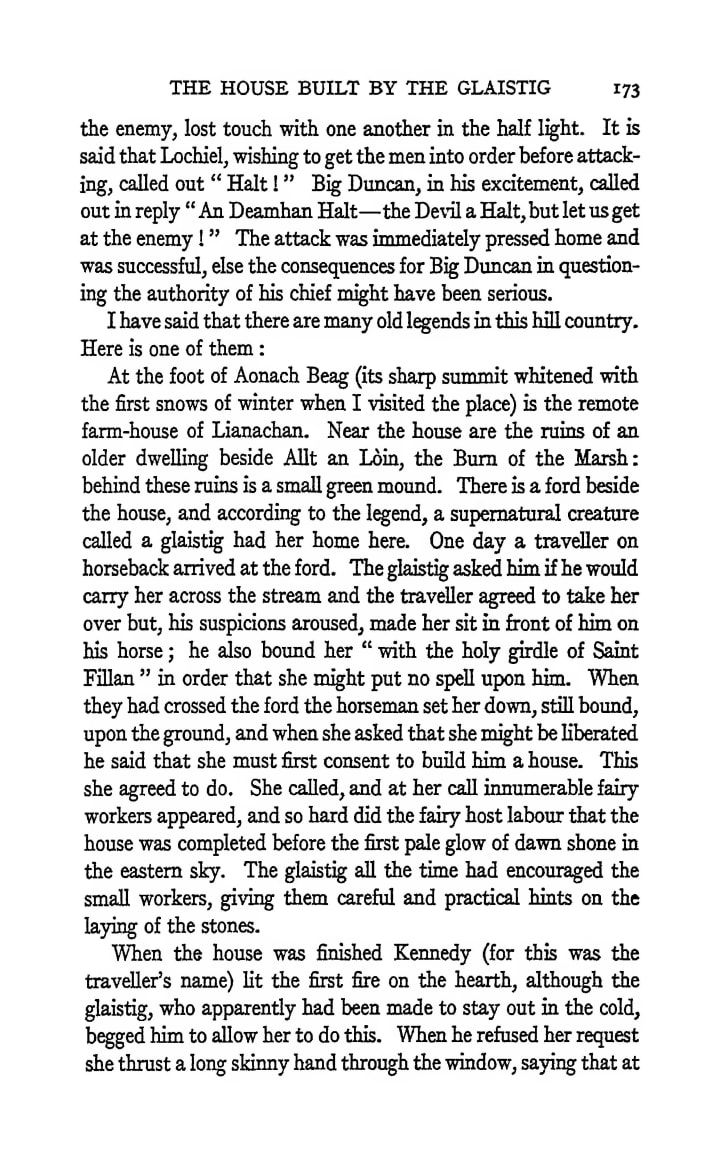
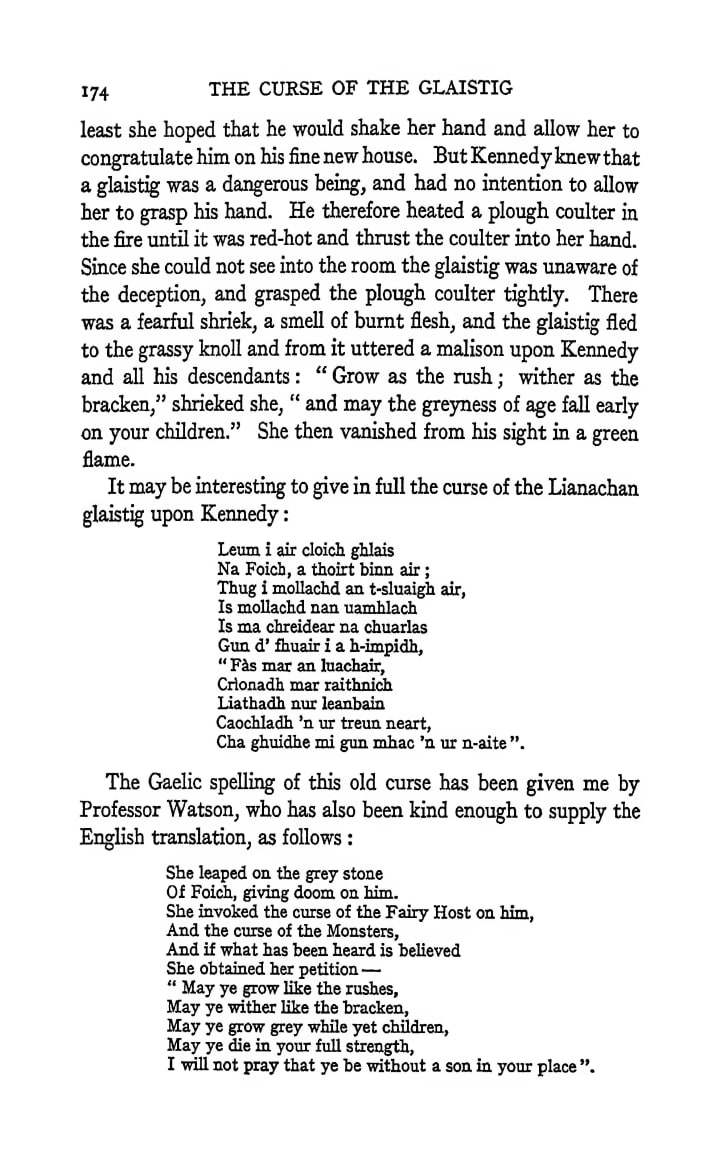
Going farther back in time, there was another book published in the year 1900 by John Gregorson Campbell, the Minister of Tiree, with an entire section about the Glaistig. The chapter on the Glaistig is about 9,000 words in length, and you can find it online right here at Project Gutenberg: Superstitions of the Highlands and Islands of Scotland - Chapter III - Tutelary Beings - The Glaistig.
Reading folklore from over a hundred years ago sure is fascinating.
There are more contemporary books and references on Scottish folklore that reference the Glaistig, like Giants, Monsters, and Dragons: An Encyclopedia of Folklore, Legend, and Myth by Carol Rose.
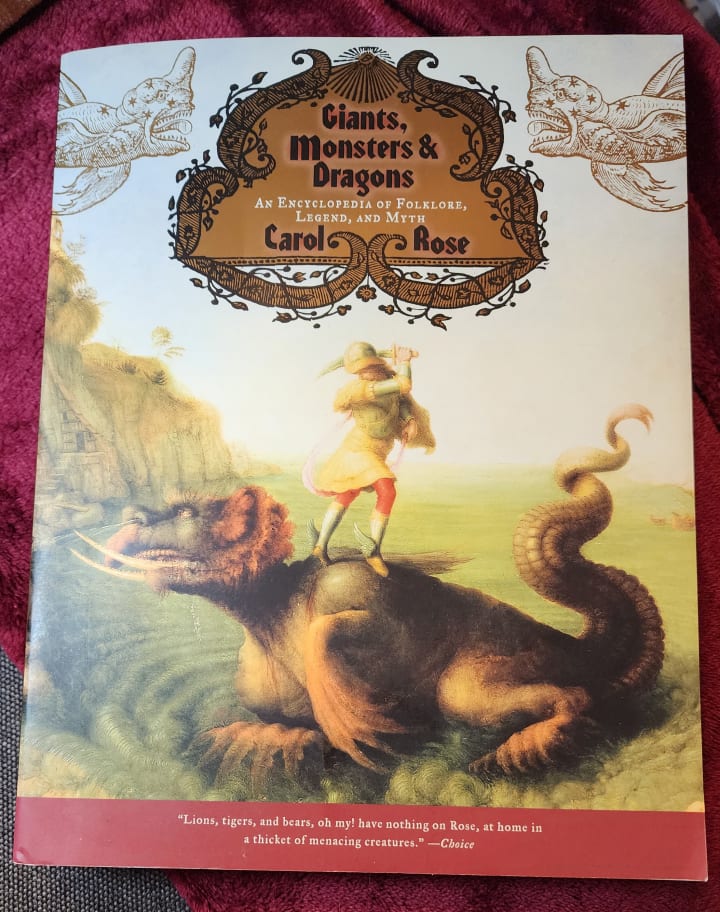
The legends of the Glaistig haven't changed much in the past 100 years, thanks to folklorists like John Gregorson Campbell and Seton Gordon, who not only keep the traditions alive but also document them for everyone else who hasn't heard the oral traditions. Without records like these, where would we be?
Relevant & Related
- If you find the history of languages fascinating, like me, check out 1) How to Tell Apart Scottish-Gaelic and Irish Gaelic by History With Hilbert, 2) Scottish Gaelic: Explained, and 3) History of the Irish Language.
- A short film from 2021 named Glaistig won quite a few awards. Give it a watch.
- Myth Legend & Lore, created by author Siobhán Clark, has a ~20-minute podcast on YouTube: The Glaistig in the folklore of the Scottish Highlands & Islands.
- Warrior Poet shares the tale of The Glaistig of Glenachulish passed down as an oral tradition.
- Aunt Li-Anne told the story of The Glaistig Lady at the 2022 Highland Games in San Diego.
- If you'd like to read about more strange happenings in the United Kingdom, I wrote about a controversial creature in the Owlman of Mawnan, Cornwall.
- You may also enjoy reading up on La Patasola of South American Folklore.
~
Originally published in my weekly newsletter, Into Horror History —every week, I explore the history and lore of horror, from influential creators to obscure events. Cryptids, ghosts, folklore, books, music, movies, strange phenomena, urban legends, psychology, and creepy mysteries.
About the Creator
J.A. Hernandez
J.A. Hernandez enjoys horror, playing with cats, and hiding indoors away from the sun. Also, books. So many books—you wouldn't believe.
He runs a weekly newsletter called Into Horror History and writes fiction.
https://www.jahernandez.com






Comments
There are no comments for this story
Be the first to respond and start the conversation.